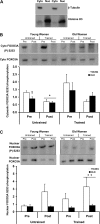Resistance exercise, skeletal muscle FOXO3A, and 85-year-old women
- PMID: 20139145
- PMCID: PMC2844061
- DOI: 10.1093/gerona/glq005
Resistance exercise, skeletal muscle FOXO3A, and 85-year-old women
Abstract
This investigation examined Akt-FOXO3A signaling in young women (YW) and old women (OW) before and after 12 weeks of high-intensity resistance training. Muscle biopsies were taken from the vastus lateralis before and immediately after resistance exercise (RE) in the untrained and trained states. In response to RE in YW and OW, phospho Akt Thr308 increased in untrained and trained states, with no change on Ser473 site. FOXO3A-Ser253 site was dephosphorylated in untrained state among YW and OW, and nuclear phospho-FOXO3A increased mainly in YW in trained state. In the basal state, OW displayed lower cytosolic phospho-FOXO3A before training, higher total nuclear FOXO3A, and a trend for higher nuclear-to-cytosolic FOXO3A ratio versus YW after 12 weeks. Basal level MuRF-1 and myostatin mRNA decreased in YW, while OW increased myostatin mRNA after 12-weeks. These data suggest that FOXO3A signaling and FOXO3A-related target gene expression are altered in OW and may partially explain the attenuated training adaptations previously reported in these octogenarian women.
Figures





Similar articles
-
Proteolytic gene expression differs at rest and after resistance exercise between young and old women.J Gerontol A Biol Sci Med Sci. 2007 Dec;62(12):1407-12. doi: 10.1093/gerona/62.12.1407. J Gerontol A Biol Sci Med Sci. 2007. PMID: 18166693
-
Improvements in whole muscle and myocellular function are limited with high-intensity resistance training in octogenarian women.J Appl Physiol (1985). 2009 May;106(5):1611-7. doi: 10.1152/japplphysiol.91587.2008. Epub 2009 Feb 26. J Appl Physiol (1985). 2009. PMID: 19246651 Free PMC article.
-
Molecular adaptations to aerobic exercise training in skeletal muscle of older women.J Gerontol A Biol Sci Med Sci. 2010 Nov;65(11):1201-7. doi: 10.1093/gerona/glq109. Epub 2010 Jun 21. J Gerontol A Biol Sci Med Sci. 2010. PMID: 20566734 Free PMC article.
-
Time course of proteolytic, cytokine, and myostatin gene expression after acute exercise in human skeletal muscle.J Appl Physiol (1985). 2007 Nov;103(5):1744-51. doi: 10.1152/japplphysiol.00679.2007. Epub 2007 Sep 6. J Appl Physiol (1985). 2007. PMID: 17823296
-
Myogenic gene expression at rest and after a bout of resistance exercise in young (18-30 yr) and old (80-89 yr) women.J Appl Physiol (1985). 2006 Jul;101(1):53-9. doi: 10.1152/japplphysiol.01616.2005. Epub 2006 Apr 6. J Appl Physiol (1985). 2006. PMID: 16601301
Cited by
-
Effects of FOXO genotypes on longevity: a biodemographic analysis.J Gerontol A Biol Sci Med Sci. 2010 Dec;65(12):1285-99. doi: 10.1093/gerona/glq156. Epub 2010 Sep 30. J Gerontol A Biol Sci Med Sci. 2010. PMID: 20884733 Free PMC article.
-
Potential mechanisms involved in regulating muscle protein turnover after acute exercise: A brief review.Front Physiol. 2023 Jan 9;13:1106425. doi: 10.3389/fphys.2022.1106425. eCollection 2022. Front Physiol. 2023. PMID: 36699675 Free PMC article. Review.
-
Longevity-Associated Forkhead Box O3 (FOXO3) Single Nucleotide Polymorphisms are Associated with Type 2 Diabetes Mellitus in Chinese Elderly Women.Med Sci Monit. 2019 Apr 22;25:2966-2975. doi: 10.12659/MSM.913788. Med Sci Monit. 2019. PMID: 31009445 Free PMC article.
-
Recent advances in pharmacological, hormonal, and nutritional intervention for sarcopenia.Pflugers Arch. 2018 Mar;470(3):449-460. doi: 10.1007/s00424-017-2077-9. Epub 2017 Oct 18. Pflugers Arch. 2018. PMID: 29043432 Review.
-
Skeletal muscle hypertrophy after aerobic exercise training.Exerc Sport Sci Rev. 2014 Apr;42(2):53-61. doi: 10.1249/JES.0000000000000007. Exerc Sport Sci Rev. 2014. PMID: 24508740 Free PMC article. Review.
References
-
- Nair KS. Aging muscle. Am J Clin Nutr. 2005;81:953–963. - PubMed
-
- Jorgensen SB, Treebak JT, Viollet B, et al. Role of ampkalpha2 in basal, training-, and aicar-induced glut4, hexokinase ii, and mitochondrial protein expression in mouse muscle. Am J Physiol Endocrinol Metab. 2007;292:E331–E339. - PubMed
-
- Boyle JP, Honeycutt AA, Venkat Narayan KM, et al. Projection of diabetes burden through 2050. Diabetes Care. 2001;24:1936–1940. - PubMed
-
- Trappe S, Costill D, Thomas R. Effect of swim taper on whole muscle and single muscle fiber contractile properties. Med Sci Sports Exerc. 2001;32:48–56. - PubMed
-
- Fluckey JD, Pohnert SC, Boyd SG, Cortright RN, Trappe TA, Dohm GL. Insulin stimulation of muscle protein synthesis in obese zucker rats is not via a rapamycin-sensitive pathway. Am J Physiol Endocrinol Metab. 2000;279:E182–E187. - PubMed
Publication types
MeSH terms
Substances
Grants and funding
LinkOut - more resources
Full Text Sources
Molecular Biology Databases
Research Materials

